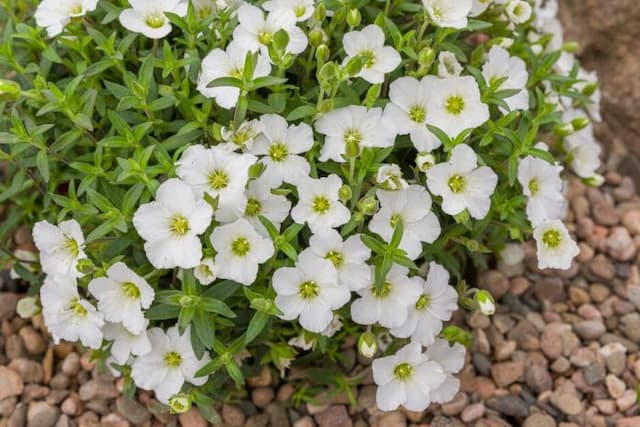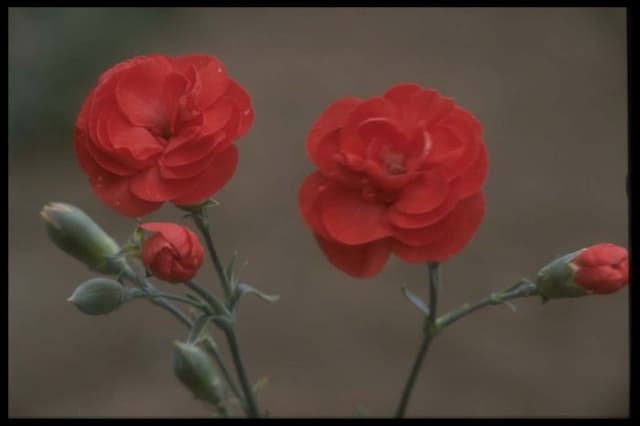Carnation Dianthus Tickled Pink = 'Devon Pp 11' (PBR) (Scent First Series) (p)
![pink [Tickled Pink]](/_next/image?url=https%3A%2F%2Fplants-admin.emdemapps.com%2Fimages%2Fplants%2F%2Fimages%2F604b64657faed.png&w=3840&q=75)
ABOUT
The Dianthus Tickled Pink, part of the Scent First Series, is an eye-catching plant known for its vibrant flowers and delightful fragrance. This variety boasts flowers with a double layer of petals, giving them a full and fluffy appearance. The petals are a soft, pastel pink color and commonly feature a unique, darker pink or coral eye that stands out at the center, adding to the visual interest. The edges of the petals have a frilled or serrated texture, which contributes to the overall delicate and ornate look of the bloom. The flowers exude a strong, spicy-sweet scent that is characteristic of many dianthus varieties. This captivating aroma adds another layer of enjoyment to gardens or landscapes where these plants are featured. The foliage of the Tickled Pink dianthus is slender and bluish-green in color. The leaves are long, lance-shaped, and form a neat, dense clump which provides a contrasting backdrop to the bright and showy flowers. The plant has an upright and tidy growth habit, making it a versatile choice for gardens, borders, and decorative containers where its colorful display and perfume can be relished up close.
About this plant
 Names
NamesFamily
Caryophyllaceae.
Synonyms
Tickled Pink Dianthus, Pink Dianthus, Devon Cottage Tickled Pink, Scent First Tickled Pink.
Common names
Dianthus 'Devon Pp11'.
 Toxicity
ToxicityTo humans
The common name for Dianthus Tickled Pink is Pink. Typically, Pinks are not considered toxic to humans. The ingestion of any part of the Pink is unlikely to cause severe symptoms of poisoning. However, it is generally recommended to avoid eating ornamental plants, as they are not intended for consumption and may cause mild gastrointestinal upset in some individuals.
To pets
The common name for Dianthus Tickled Pink is Pink. Pinks are generally considered non-toxic to pets. Eating parts of the plant might occasionally lead to mild gastrointestinal upset, such as vomiting or diarrhea, but serious toxicity is not expected. Owners should still discourage pets from ingesting plants as a precaution.
 Characteristics
CharacteristicsLife cycle
Perennials
Foliage type
Evergreen
Color of leaves
Blue-green
Flower color
Pink
Height
1 foot 6 inches (45 centimeters)
Spread
1 foot (30 centimeters)
Plant type
Herb
Hardiness zones
5
Native area
Europe
Benefits
 General Benefits
General Benefits- Attracts pollinators - Dianthus Tickled Pink is known for attracting bees and butterflies, which are essential for pollination.
- Easy to grow - This plant is low-maintenance, making it suitable for both novice and experienced gardeners.
- Long blooming period - It produces flowers for an extended period, usually from late spring to early fall.
- Fragrant flowers - The blooms emit a pleasant spicy-sweet fragrance, which can add aroma to gardens and outdoor spaces.
- Drought-tolerant - Once established, Dianthus Tickled Pink is quite tolerant of dry conditions, requiring minimal watering.
- Compact size - It is well-suited for small gardens or containers because of its manageable size and mounding habit.
- Winter hardy - This plant can survive in colder climates, making it suitable for a wide range of growing zones.
 Medical Properties
Medical PropertiesThis plant is not used for medical purposes.
 Air-purifying Qualities
Air-purifying QualitiesThis plant is not specifically known for air purifying qualities.
 Other Uses
Other Uses- Cut Flowers: The vibrant petals of the Dianthus make beautiful cut flowers for bouquets and floral arrangements, adding pops of color and a sweet fragrance to the indoor setting.
- Pressed Flowers: The flat nature of Dianthus petals makes them ideal for pressing and using in crafts like handmade paper making, greeting cards, or bookmarks.
- Decorative Garnishes: Edible varieties of Dianthus can be used to add a colorful and edible garnish to salads, desserts, and drinks to enhance presentation.
- Perfume Manufacture: The essential oils extracted from the Dianthus flowers are sometimes used in creating perfumes, offering a spicy floral note to the blend.
- Textile Dyeing: Historically, the Dianthus plant was used as a source of dye for coloring textiles with its natural pigments.
- Culinary Experiments: Some chefs use the edible flowers in innovative culinary experiments, such as infusing sugars, syrups, or even making floral-flavored ice creams.
- Symbolic Gifts: The Dianthus is often associated with love, fascination, and distinction, making it a fitting ornamental gift for special occasions conveying these messages.
- Photography Subject: Due to their striking colors and forms, Dianthus flowers are coveted subjects for garden photography and botanical studies.
- Companion Planting: Gardeners sometimes use Dianthus to attract pollinators like bees and butterflies to their gardens, benefiting other plants nearby.
- Scented Sachets: The dried petals of Dianthus can be used to create scented sachets, which can be placed in drawers or closets to impart a pleasant fragrance to linens and clothes.
Interesting Facts
 Feng Shui
Feng ShuiThe plant Dianthus is not used in Feng Shui practice.
 Zodiac Sign Compitability
Zodiac Sign CompitabilityThe plant Dianthus is not used in astrology practice.
 Plant Symbolism
Plant Symbolism- Love: Dianthus species have long been associated with love due to their frequent use in bridal bouquets and their romantic frilled petals.
- Admiration: Their bright pink color signifies admiration, making them a popular choice to express this feeling.
- Boldness: The vibrant color of the 'Tickled Pink' variety conveys a message of boldness and daring.
- Purity: Despite the bold coloring, dianthus flowers still carry a symbol of purity, stemming from their traditional use in ancient ceremonial events.
- Affection: Dianthus blooms are often used to convey affection between friends, family members, and romantic partners due to their endearing appearance.
- Devotion: The lasting nature of the Dianthus blooms suggests a long-term commitment or devotion.
 Water
WaterThe Pink Dianthus, commonly known as the Pinks, prefers to be watered once the soil surface appears dry, typically every one to two weeks, depending on the local climate and season. Utilize a gentle stream of water to avoid disturbing the soil or damaging the foliage, aiming to moisten the soil to a depth of about an inch. During the growing season, ensure it receives about one inch of water weekly, which equates to approximately 0.6 gallons for an average-sized plant.
 Light
LightThe Pink Dianthus thrives best in full sunlight, meaning at least six hours of direct sunlight per day. It should be positioned in a spot where it can receive unfiltered, bright light throughout the day, which is critical for the plant to achieve bountiful blooms and maintain healthy foliage.
 Temperature
TemperatureThe Pink Dianthus can tolerate a wide range of temperatures but grows optimally when the temperature is between 60°F and 75°F. It can survive minimum temperatures down to about 40°F, but prolonged exposure to temperatures below this can be harmful. During hot summers, ensure that nighttime temperatures do not consistently exceed 85°F for extended periods, as this may impede flowering.
 Pruning
PruningPruning the Pink Dianthus should be done to remove spent blooms and encourage a bushier plant with more flowers. Deadheading, or removing faded flowers, can be done throughout the blooming season to promote continuous flowering. It's also beneficial to give the plant a more substantial trim in early spring to remove any winter damage and stimulate new growth.
 Cleaning
CleaningAs needed
 Soil
SoilFor a Dianthus Tickled Pink, commonly known as 'Carnation,' the best soil mix is well-draining, loamy, and slightly alkaline with a pH of 6.7 to 7.3. A mix composed of one part garden soil, one part coarse sand or perlite, and one part peat or compost will create an ideal environment for it to flourish.
 Repotting
RepottingCarnations, like the Dianthus 'Tickled Pink', should generally be repotted every 1-2 years to refresh the soil and to accommodate their growing root system. Repotting is best done in the spring.
 Humidity & Misting
Humidity & MistingCarnations such as Dianthus 'Tickled Pink' prefer average to low humidity levels. As long as the plant is in well-draining soil and not in an overly damp environment, humidity is not a significant factor for its health.
 Suitable locations
Suitable locationsIndoor
Place Dianthus 'Tickled Pink' in a sunny spot, water regularly, avoid excess humidity.
Outdoor
Plant Dianthus 'Tickled Pink' in full sun, well-draining soil, water when dry.
Hardiness zone
4-9 USDA
 Life cycle
Life cycleThe life of the Tickled Pink Dianthus begins with seed germination, which occurs in a well-draining soil mix under conditions that mimic its natural temperate habitat, typically during the cooler parts of spring or fall. Once germinated, the seedling grows, sprouting its first true leaves and developing a root system. As it matures into a vegetative state, it produces dense tufts of slender, gray-green foliage and begins to form sturdy stems. Flowering occurs in late spring to early summer, with the plant producing fragrant, double pink flowers that attract pollinators such as bees and butterflies. After the flowering stage, seed development begins if pollination was successful, and once seeds mature, they can be dispersed to start a new generation. In subsequent years, the Tickled Pink Dianthus will continue this cycle, experiencing periods of growth, blooming, and dormancy, typically becoming more robust and prolific with each growing season.
 Propogation
PropogationPropogation time
Spring-Early Summer
The most popular method of propagating the Dianthus 'Tickled Pink' is through cuttings. This is typically done in late spring or early summer when the plant is actively growing. Take stem cuttings that are about 4 to 6 inches (10 to 15 centimeters) long, making sure that each cutting has a few leaves. Dip the cut end in rooting hormone to encourage root development and then insert the cuttings into a well-draining soil mix. It is crucial to keep the soil moist but not waterlogged and to provide bright, indirect light until the cuttings have rooted. This process usually takes several weeks, after which the new plants can be transplanted into pots or the garden.


![Pink [Tequila Sunrise]](/_next/image?url=https%3A%2F%2Fplants-admin.emdemapps.com%2Fimages%2Fplants%2F%2Fimages%2F604b5d995d06e.png&w=640&q=75)






